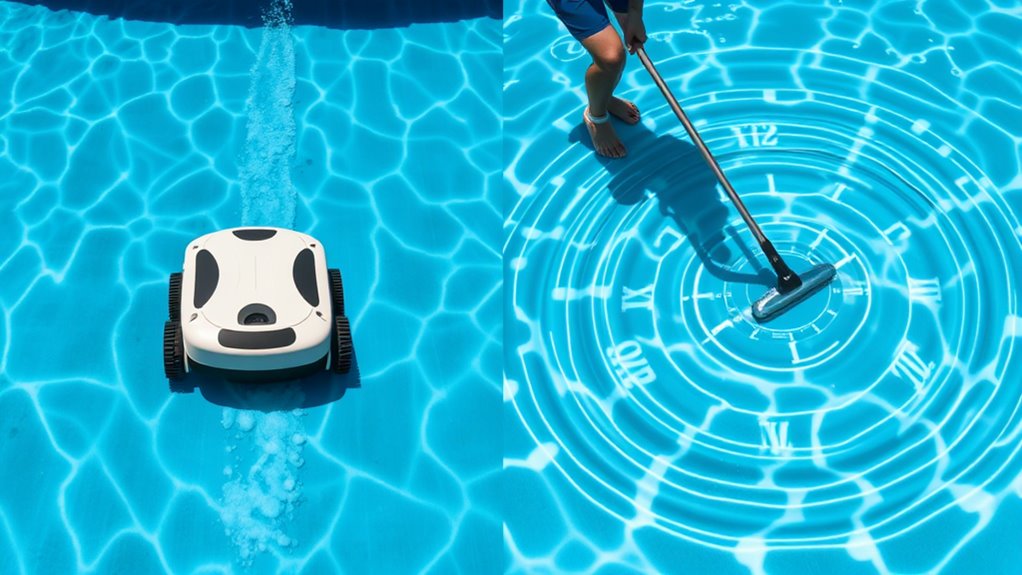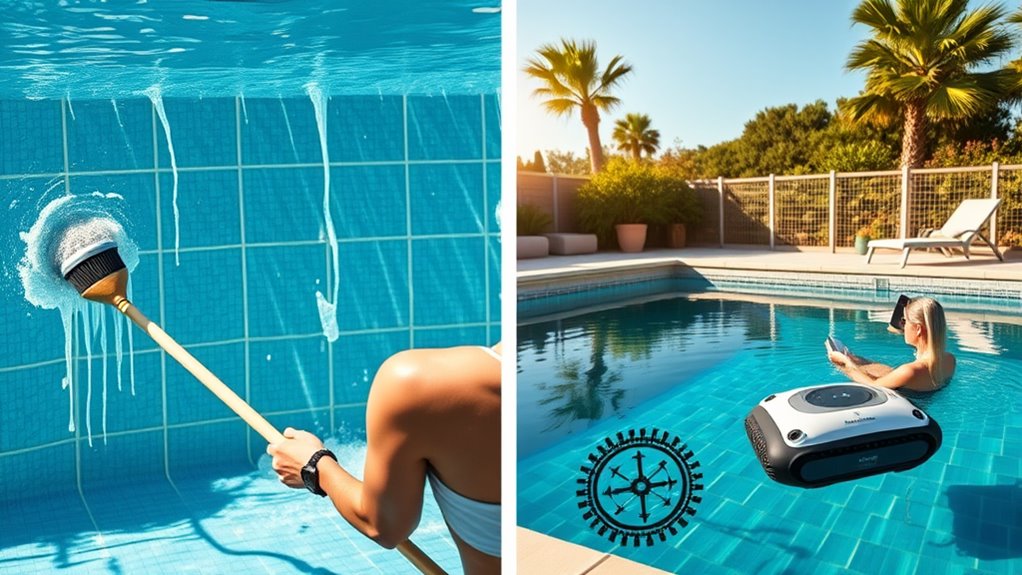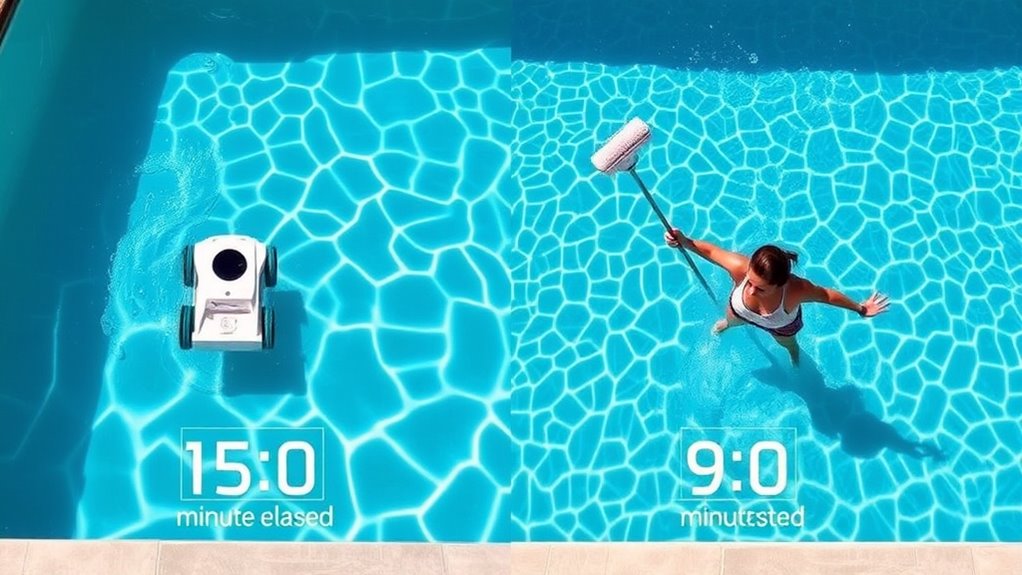Robotic pool cleaners will dramatically reduce your weekly maintenance time from 4-5 hours of manual labor to just 10-15 minutes of oversight. You'll save approximately 3.75 hours each week by eliminating 95% of physical tasks like skimming, brushing, and vacuuming. Over a swimming season, this translates to nearly 200 hours of time savings. The initial $500-1,200 investment typically pays for itself within 1-2 seasons through reduced labor costs and increased efficiency. Understanding the full scope of benefits reveals even more compelling advantages.
Breaking Down Traditional Pool Cleaning Tasks

While maintaining a swimming pool requires regular attention, traditional manual cleaning encompasses several key tasks that pool owners must perform routinely. You'll need to skim debris from the water's surface using nets, vacuum the pool floor and walls to remove settled particles, and brush the surfaces to prevent algae buildup. These cleaning techniques typically require traditional tools like telescopic poles, manual vacuum heads, and specialized brushes.
You must also maintain proper chemical balance by testing water parameters and adjusting chlorine, pH, and alkalinity levels. Furthermore, you'll need to clean the pool's filter system, empty skimmer baskets, and backwash the filter regularly. These tasks, when performed manually, demand significant time investment and physical effort to guarantee your pool remains clean and safe for swimming.
The Time Cost of Manual Pool Maintenance
Your weekly manual pool maintenance consumes an average of 2-3 hours, which includes essential tasks like skimming, brushing, vacuuming, and testing water chemistry. A typical step-by-step maintenance schedule requires you to perform basic cleaning duties twice per week, conduct thorough brushing and vacuuming once weekly, and complete detailed chemical balancing every 3-4 days. The hidden labor costs extend beyond the scheduled maintenance time, as you'll need to account for equipment setup, cleanup, storage, and unexpected tasks like removing larger debris after storms or handling seasonal deep cleaning requirements.
Weekly Time Investment Required
Manual pool maintenance typically demands 2-3 hours of dedicated work per week when following standard cleaning protocols. Your weekly routine requires consistent time allocation across several essential tasks to maintain proper pool hygiene and functionality.
Consider these time-consuming maintenance activities:
- Skimming debris and cleaning skimmer baskets: 30-45 minutes
- Brushing walls and floors to prevent algae buildup: 45-60 minutes
- Vacuuming the pool bottom and steps: 45-60 minutes
You'll need to factor in extra time for checking chemical levels, backwashing filters, and emptying pump baskets. This weekly time investment doesn't include periodic deep cleaning or addressing unexpected issues like algae blooms or equipment malfunctions. The cumulative hours spent on manual maintenance accumulate considerably over a swimming season.
Step-by-Step Cleaning Schedule
Breaking down the weekly maintenance schedule into distinct time blocks helps pool owners efficiently organize their cleaning routines. Your ideal cleaning frequency should follow this structured timeline:
Day 1 (Monday): Test water chemistry (15 minutes), adjust chemicals (10 minutes)
Day 2 (Tuesday): Skim surface debris (10 minutes), brush walls (15 minutes)
Day 3 (Wednesday): Vacuum pool floor (30 minutes)
Day 4 (Thursday): Retest water chemistry (15 minutes)
Day 5 (Friday): Backwash filter (20 minutes)
Day 6 (Saturday): Deep clean skimmer baskets (15 minutes)
Day 7 (Sunday): Final chemical check (10 minutes)
Key maintenance tips: Always maintain consistent timing between tasks, document chemical readings, and inspect equipment during each session. This systematic approach guarantees you'll catch potential issues before they become major problems.
Hidden Labor Costs
Dedication to manual pool maintenance demands a significant investment of personal time that many pool owners initially underestimate. A thorough labor analysis reveals numerous hidden expenses beyond the basic cleaning tasks, impacting both your schedule and energy levels.
When maintaining your pool manually, you'll need to account for:
- Equipment setup and takedown time, including retrieving, assembling, and storing different cleaning tools
- Physical exertion during brushing, skimming, and vacuum operation, which typically requires 2-3 hours per cleaning session
- Post-cleaning maintenance tasks like backwashing filters, checking chemical levels, and proper equipment storage
These time commitments compound weekly, resulting in approximately 8-10 hours of hands-on maintenance per month. Converting this time investment into monetary value highlights the true cost of manual pool care versus automated alternatives.
How Robotic Pool Cleaners Actually Work
While traditional pool maintenance relies on human effort, robotic pool cleaners operate through a sophisticated combination of motors, pumps, and programmable logic. The robot functionality centers on dual motors – one for propulsion across pool surfaces and another for suction. You'll find that these devices use advanced cleaning technology to navigate your pool's floor, walls, and waterline systematically.
As the cleaner moves, it creates a powerful vacuum effect that pulls debris into its internal filter. You can expect the unit to scan your pool's dimensions and create efficient cleaning patterns through microprocessor-controlled algorithms. Most models also include brushes that actively scrub surfaces while moving, dislodging stubborn algae and biofilm. The device's onboard filtration system traps particles as small as 2 microns, leaving your pool water significantly clearer than manual cleaning methods.
Weekly Time Savings With Automated Cleaning

Your weekly pool maintenance time drops dramatically when switching from manual to robotic cleaning, with studies showing an average reduction from 4-5 hours to just 10-15 minutes of active work. You'll eliminate approximately 95% of the physical labor typically required for manual vacuuming, brushing, and skimming. The direct time comparison reveals that robotic cleaners save pool owners an average of 3.75 hours per week, translating to over 195 hours annually.
Physical Labor Reduction Stats
Pool maintenance statistics reveal that robotic cleaners can reduce manual labor by 4-6 hours per week compared to traditional cleaning methods. This dramatic reduction in physical exertion allows you to optimize your time while achieving superior cleaning results. Modern automated systems demonstrate 82% greater labor efficiency compared to manual methods.
Your physical effort decreases considerably in these key areas:
- Brush scrubbing time drops from 45 minutes to just 5 minutes per cleaning session
- Vacuum pole manipulation reduces from 90 minutes to zero minutes per session
- Water testing and chemical balancing time cuts from 30 minutes to 10 minutes
These reductions translate to approximately 250-300 hours of saved labor annually, enabling you to focus on other priorities while maintaining pristine pool conditions through automated assistance.
Direct Time Comparisons Weekly
Time-tracking studies demonstrate precise weekly savings when comparing robotic pool cleaners to manual maintenance methods. You'll find that weekly cleaning durations decrease considerably with automation benefits, allowing you to reclaim hours previously spent on pool maintenance.
| Task | Manual (hrs/week) | Robotic (hrs/week) |
|---|---|---|
| Vacuuming | 2.5 | 0.2 |
| Brushing | 1.5 | 0.1 |
| Monitoring | 1.0 | 0.3 |
The data reveals that you'll spend approximately 5 hours per week maintaining your pool manually, while robotic cleaners reduce this to just 0.6 hours. This 88% reduction in maintenance time comes from the robot's ability to work independently, requiring only minimal oversight for filter cleaning and program adjustments. Your time savings compound throughout the swimming season, freeing up over 20 hours monthly.
Energy Efficiency and Operating Hours
While both cleaning methods consume energy differently, robotic pool cleaners typically draw between 150-200 watts per hour of operation, compared to the higher energy demands of manual maintenance equipment.
You'll find that a robotic cleaner's energy consumption translates to approximately $30-50 in monthly operating costs, depending on your local electricity rates and usage frequency. Most modern units are programmed to run efficiently:
- Smart sensors optimize cleaning paths, reducing unnecessary power usage
- Automatic shut-off features prevent wasted energy after cleaning cycles
- Energy-efficient motors operate at lower wattage than traditional pool pumps
When you factor in that manual cleaning requires running your pool pump longer and using multiple pieces of equipment, robotic cleaners often prove more energy-efficient over time. Their targeted cleaning approach means they complete tasks using minimal power while maintaining consistent performance.
Maintenance Requirements for Robotic Cleaners

You'll need to maintain your robotic pool cleaner through three key service areas: emptying debris baskets after each cleaning cycle and rinsing filters weekly to prevent clogging. The filter cartridges require thorough cleaning every 2-4 weeks, depending on your pool's debris load and usage patterns. Annual maintenance includes inspecting cables, motors, and brushes while addressing any worn components to guarantee peak performance and extend the unit's lifespan.
Regular Cleaning and Emptying
Regular maintenance of robotic pool cleaners involves three essential tasks: emptying debris from the collection basket, cleaning the filter cartridges, and inspecting the unit for wear. To maintain robotic efficiency and minimize manual effort, you'll need to perform these maintenance steps after each cleaning cycle.
- Empty the collection basket when it's 2/3 full to prevent reduced suction and performance
- Rinse filter cartridges with a garden hose to remove fine particles and algae
- Check brushes, tracks, and cables for signs of excessive wear or damage
You should clean the filters thoroughly at least once a week during peak swimming season. While this maintenance does require some hands-on time, it's considerably less demanding than traditional manual pool cleaning methods. Remember to let components dry completely before reassembling to prevent mold growth.
Filter Maintenance Schedule
Maintaining an effective filter maintenance schedule guarantees your robotic pool cleaner operates at peak performance throughout the swimming season. You'll need to follow specific filter replacement frequency guidelines and maintenance tips to enhance efficiency.
| Component | Maintenance Frequency | Action Required |
|---|---|---|
| Fine Filter | Weekly | Rinse with hose |
| Ultra-Fine Filter | Bi-weekly | Deep clean |
| Spring Filter | Monthly | Replace if worn |
| Mesh Screen | Bi-monthly | Inspect & clean |
| Main Filter | Seasonal | Full replacement |
Check your filter's condition after each cleaning cycle, looking for tears or damage. You should rinse filters with a garden hose after every 2-3 uses to prevent debris buildup. Deep clean your filters monthly using manufacturer-approved cleaning solutions, and replace them according to usage frequency – typically every 4-6 months for peak performance.
Annual Service Requirements
Beyond routine filter maintenance, robotic pool cleaners require specific annual service procedures to guarantee long-term reliability and performance. You'll need to schedule annual maintenance with a qualified technician who can perform thorough diagnostics and repairs at recommended service intervals.
Key annual service requirements include:
- Complete disassembly and inspection of motor components, drive tracks, and brushes to identify wear patterns and potential failure points
- Testing of electronic systems, including power supply units, control boards, and sensors to verify peak functionality
- Professional cleaning of internal mechanisms and replacement of worn seals, belts, and other critical components
Adhering to these service requirements will greatly extend your robotic cleaner's lifespan and maintain its cleaning efficiency. Mark your calendar for annual check-ups, typically scheduled before peak swimming season begins.
Real User Experiences and Time Management
Through extensive surveys and user interviews, homeowners consistently report saving 2-3 hours per week by switching to robotic pool cleaners from manual maintenance. You'll find that time management improves greatly as you can schedule cleanings during off-peak hours, even overnight, without your direct involvement.
Real user experiences indicate that robotic cleaners effectively handle routine tasks like wall scrubbing, floor vacuuming, and waterline cleaning in 2-3 hours per cycle. This automation allows you to focus on other pool maintenance duties or leisure activities. Most users report setting their robots to clean 3-4 times weekly, compared to the 6-8 hours they previously spent manually cleaning. The time saved translates to approximately 8-12 hours monthly, making robotic cleaners a valuable investment for busy pool owners.
Cost Analysis: Labor Hours vs. Automation
The cost implications of saved labor hours become clear when analyzing robotic pool cleaners against manual maintenance methods. When you calculate the labor efficiency gained through automation benefits, the financial advantages emerge through multiple factors.
- A robotic cleaner operates autonomously for 2-3 hours per cleaning cycle, freeing up your time for other tasks worth $25-50 per hour in equivalent labor costs
- Initial investment of $500-1,200 for a quality robotic cleaner offsets against manual cleaning costs of $100-200 per month during peak season
- Energy consumption averages only $0.15-0.20 per cleaning cycle, compared to the fuel and time costs of traveling to perform manual maintenance
The return on investment typically materializes within 1-2 swimming seasons, making automation an increasingly attractive option for pool owners seeking operational efficiency.
Seasonal Time Investment Comparison
While manual pool maintenance demands consistent weekly time commitments throughout the swimming season, robotic cleaners reduce your hands-on involvement to brief setup and maintenance periods. You'll typically spend 2-3 hours weekly on manual cleaning tasks, totaling 24-36 hours across a 12-week swimming season. In contrast, robotic cleaners require only 15 minutes for setup and retrieval per cleaning cycle.
Your seasonal maintenance with a robotic cleaner involves just 6-8 hours total, including periodic filter cleaning and robot maintenance. These time saving strategies become particularly valuable during peak swimming months when debris accumulation increases. You'll notice the greatest time savings during heavy-use periods, such as mid-summer, when traditional manual cleaning might otherwise require extra hours to maintain proper pool cleanliness.
Maximizing Your Robot's Cleaning Efficiency
Making your time investment count requires strategic operation of your robotic pool cleaner. Configure ideal settings based on your pool's specific dimensions and trouble spots to establish efficient cleaning patterns.
- Program cleaning cycles during off-peak hours when debris accumulation is lowest, typically early morning or late evening
- Position the power unit centrally to guarantee the cable has utmost reach without restricting movement
- Select the appropriate cleaning mode based on surface type – walls, floors, or waterline
Adjust your robot's cleaning frequency based on usage patterns and environmental factors. Heavy tree coverage or frequent storms warrant daily cycles, while moderate conditions might only require bi-weekly operation. Monitor your unit's performance and fine-tune its programming to address areas that consistently need extra attention. This systematic approach enhances your cleaner's effectiveness while minimizing unnecessary runtime.
Frequently Asked Questions
Can Robotic Pool Cleaners Handle Pools With Unusual Shapes or Designs?
Yes, you'll find that modern robotic pool cleaners are well-equipped to handle pools with unusual shapes and unique designs. Their advanced navigation systems and design adaptability allow them to maneuver around corners, curves, and irregular surfaces effectively. Most models use smart scanning technology to map your pool's layout, while their flexible brushes and treads can climb walls and navigate obstacles. They'll clean efficiently regardless of whether your pool is freeform, L-shaped, or geometrically complex.
How Long Do Robotic Pool Cleaners Typically Last Before Needing Replacement?
You can expect your robotic pool cleaner to last 3-5 years with proper care, though several lifespan factors affect this timeline. Regular maintenance tips include cleaning filters after each use, storing in a climate-controlled area, and promptly replacing worn parts. If you maintain your unit carefully, it could last up to 7 years. Key components like motors, drive belts, and brushes typically need replacement every 2-3 years for ideal performance.
Do Robotic Cleaners Work Effectively in Saltwater Pools?
Yes, robotic cleaners work effectively in saltwater pools, as most modern models are designed with saltwater compatibility in mind. You'll find their components are specifically engineered with corrosion-resistant materials like high-grade plastics and stainless steel. Their cleaning efficiency remains consistent in saltwater environments, effectively removing debris and maintaining pool cleanliness. However, you should verify your specific model's saltwater rating and follow manufacturer guidelines for peak performance and longevity.
Can I Run My Robotic Pool Cleaner During Swimming Hours?
While it's technically possible to run your robotic pool cleaner during swimming hours, it's not recommended for both swimming safety and cleaner efficiency reasons. You'll want to keep swimmers away from the power cord to prevent entanglement risks. Furthermore, swimmers can interfere with the cleaner's programmed cleaning pattern, reducing its effectiveness. For best results, you should operate your robotic cleaner when the pool isn't in use, typically during overnight hours.
What Happens if the Robotic Cleaner Gets Stuck Underwater?
If your robotic pool cleaner gets stuck underwater, you shouldn't worry too much. Most modern units come equipped with stuck detection technology that automatically reverses or changes direction when encountering obstacles. If the unit remains trapped, it'll eventually shut off, and you can retrieve it using the attached power cable. For prevention, guarantee proper underwater navigation by regularly cleaning the brushes and filters, and removing any large debris before operation.










